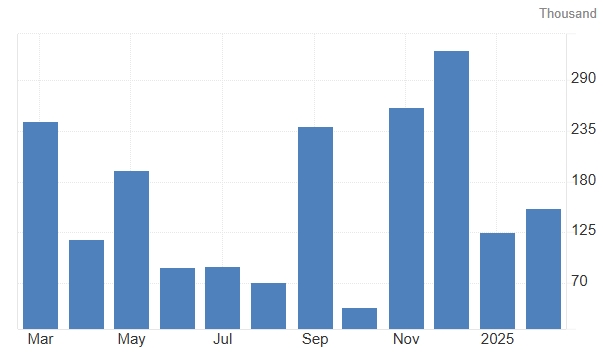March Nonfarm Payroll Preview: Tariff Impact Takes Hold, U.S. Employment Continues to Soften – Is the S&P 500’s Decline Far From Over?
TradingKey - On April 4, the U.S. Bureau of Labor Statistics will release the March nonfarm payroll report. Wall Street expects that, due to the impact of Trump's tariffs, U.S. companies' hiring intentions have weakened, and nonfarm payrolls will decline.
According to a Bloomberg survey of economists, U.S. nonfarm payrolls are expected to increase by 138,000 in March, down from 151,000 in February, with the unemployment rate projected to remain at 4.1%. If the actual figures align with forecasts, the three-month average job growth would be the lowest since October 2024.

[U.S. Nonfarm Payrolls, Source: Trading Economics]
Morgan Stanley projects that nonfarm payrolls will rise by just 130,000 in March—well below the six-month average of 190,000. The slowdown is attributed to weaker federal government hiring and an increase in layoffs, with modest private-sector job gains unable to fully offset the decline.
Job growth for the first two months of 2025 has already fallen short of market expectations, and the unemployment rate unexpectedly rose to 4.1% in February. As new U.S. tariffs take effect and recent economic data point to rising inflation, cooling labor markets, and sluggish growth, Wall Street’s concerns about stagflation or a potential recession have intensified.
- The Atlanta Fed’s GDPNow model previously forecasted a 2.5% contraction in U.S. Q1 GDP.
- The U.S. ISM Manufacturing PMI for March came in at 49, marking the first contraction of the year.
- The annualized core PCE index for February rebounded to 2.8%, the highest since December of the previous year.
- The number of job openings in the U.S., as measured by the JOLTS report, dropped from 7.76 million in January to 4.56 million in February. Federal government layoffs surged from 4,000 in January to 22,000, the highest since November 2020.
Human resources firm Challenger, Gray & Christmas noted that layoffs in February were driven by factors such as the U.S. Government Efficiency Department's cost-cutting measures, canceled federal contracts, trade war concerns, and corporate bankruptcies.
Morgan Stanley analysts believe vulnerabilities in the U.S. labor market are likely to intensify. Even if employment grows modestly and wages remain stable, the bar for using labor market data to dispel recession fears remains high.
Morgan Stanley expects overall market risk sentiment to be dominated by downside risks, requiring robust job growth to reverse mounting concerns about further economic weakening.
Amid rising stagflation fears, the S&P 500 has declined approximately 2.5% over the past month, while the Nasdaq Composite has dropped 4.6%. Major institutions, including Goldman Sachs andSociété Générale, have recently lowered their 2025 S&P 500 target prices.



